Review: Coolpad Defiant for T-Mobile
Aug 9, 2017, 4:30 PM by Eric M. Zeman
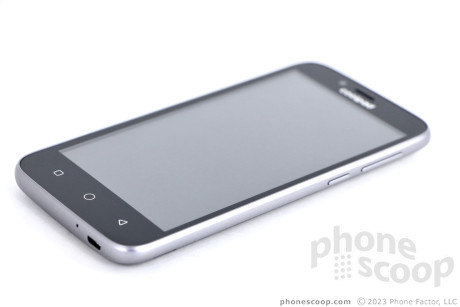
Coolpad's low-cost Defiant is an entry-level device sold by T-Mobile. Some aspects of this Android handset are great, but it is held back by some egregious missteps. Here is Phone Scoop's in-depth report about Coolpad's not-so-cool Defiant.
Hardware
Is It Your Type?
The Coolpad Defiant is one of the least expensive phones in T-Mobile's lineup. If you're in need of a basic communications tool, or simply want the lowest-cost smartphone possible, the Coolpad Defiant is a decent starting place.
Body
The Defiant is an update to the Coolpad Catalyst, which was also sold by T-Mobile. The Defiant carries over the glossy black front and matte gray rear of last year's phone, though it rounds the corners a bit. There's no question from the phone's simple design that it's an entry-level device. Everything about it comes off as pedestrian and low-cost.
Glass forms the entire face of the Defiant. It's set into a silver-ish frame. The frame forms a very thin raised rim to protect the glass from scratches. The frame has a grainy texture that I rather like. The rear is darker gray patterned plastic that comes off as a bit cheap.
Due to its thick bezels, the Defiant is not as compact as I'd like for a phone with a 5-inch display. It's also rather thick at 10.2mm. Smaller hands will find it big while those with average or larger hands should find it comfortable. The curved shape of the side edges helps the phone sit deeper in your palm. It's a one-handed phone, which I'm sure many will appreciate.
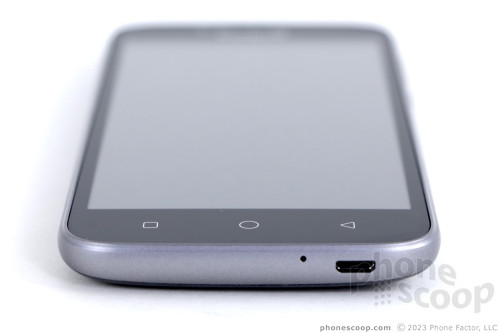
The materials and build quality are fine, considering the price point. The three major chassis components (glass, frame, rear panel) are all fitted together perfectly. I didn't see any gaps or unevenness in the seams. It looks and feels tight. The rear plastic shell is the least impressive chassis element and yet I've encountered far cheaper rear shells in my day. It snaps on firmly.
The Defiant's face is plebian. The user-facing camera is just to the left of the earpiece, while the Coolpad logo is painted on just above the display. The logo looks squished.
The biggest piece of evidence suggesting the Defiant is a low-cost phone is the display, which looks awful when the screen is off. The display itself is set far below the cover glass, and this creates a shadow as you tilt the phone around. It doesn't help that the display is gray when off, which contrasts poorly with the deep black bezels. Speaking of which, the bezels are thick all the way around. It's just not a good look. Three capacitive buttons line the Defiant's chin (app switcher, home, back.) The buttons do light up.
You'll find the screen lock button and volume toggle both on the Defiant's right edge. The buttons' good profiles make them easy to find and use. Travel and feedback was very good. I do wish the volume toggle had physical bumps or nubs to make it simple to tell up from down; the button is hardly an inch long and I often accidentally lowered the volume when I intended to raise it and vice versa. The 3.5mm headphone jack is on top and the microUSB port is on the bottom.

The rear panel is a gently bowed bit of plastic with minimal design elements. The plastic has been stamped with a diamond-like pattern that gives it some texture. It's almost impossible to see from more than a few feet away. A small circle near the top contains the main camera. The camera has a thin chrome rim and is set level with the rear surface. The dual LED flash is just off to the right. Coolpad's logo is painted on the rear, too, just above the speakerphone.
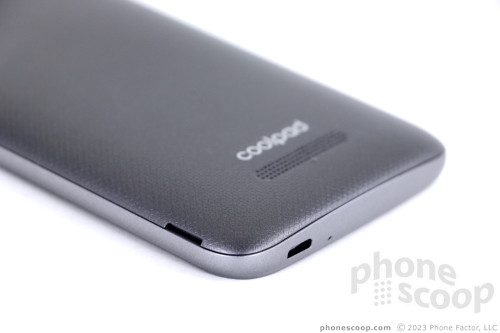
I had no problem peeling off the rear shell. The battery is removable. The microSD memory card slot is off to one side and can be accessed without removing the battery.
Coolpad's Defiant sets no trends. It is a simple smartphone that matches its price point as far as the hardware experience is concerned.
Screen
The screen is terrible. No, really, it's quite bad. The 5-inch dimensions are just fine, but the FWVGA (854 x 480) resolution is just not good enough. I haven't seen resolution this low on a phone in a long time. Had Coolpad improved the resolution one step to 960 x 540, the screen would look better. Pixels are visible everywhere and on-screen text and graphics have fuzzy borders. To make matters worse, the glass was not treated by an oleophobic coating. This means fingerprints and finger oil quickly form a layer of grime that's hard to eradicate. And then there's brightness. The phone pumps out enough light for indoor use, but it struggles outdoors. You'll have to turn the brightness all the way up to see the phone under sunlight, and even then fingerprints and high reflectivity on the glass mar the experience. Using the camera outdoors on a sunny day is all but impossible. Viewing angles are no good. It's among the worst screens I've seen on a modern phone.
Signal
The Defiant doesn't run on T-Mobile's network as well as other phones I've tested recently. It connected to 4G most of the time and yet sometimes dropped down to 3.5G and even 2G, which I haven't seen in a long time. The phone connected the majority of calls on the first dial, but it tended to drop more calls than other T-Mobile phones. It was particularly inept at holding onto the network at highway speeds. It also lacks Band 66, so it can't use the newest parts of T-Mobile's network.
Data performance was well below what I expect from a modern handset. Yes, technically, it offers 4G most of the time, but speeds were very slow. T-Mobile devices often deliver peak download speeds north of 50 Mbps, with average speeds in the high teens. The Defiant was stuck around 5 Mbps most of the time. This meant YouTube and Spotify didn't run well over the network. Instagram and Facebook were slow. Email and messaging was fine.
Sound
Phone calls are of middling quality at best. The speaker offers enough volume so you can hear calls in most places, but it creates a huge amount of distortion that I found really distracting. Calls are choppy and full of noise as they come through the earpiece. It was often hard to understand people during calls, and they said they had trouble understanding me.
The speakerphone is a bit better. Volume is good enough, but clarity is much improved. In fact, you may want to skip the earpiece and use the speakerphone for most calls because it's that much better.
Ringers and alerts should be loud enough for most people, and the vibrate alert was good.
Battery
If the Defiant has a bright spot, battery life is it. The 2,450 mAh battery is a touch smaller than those in competing models, but the low-resolution screen does a lot to help prevent power drain. The Defiant routinely delivered a full day of battery life with plenty to spare. The phone often had as much as 40% remaining when I headed to bed. Even heavy use of social networks didn't impact the battery too much. It does well.
The phone includes the simple, base Android power saver tool. It helps a little if you get into trouble.
The Defiant does not offer rapid charging nor wireless charging.
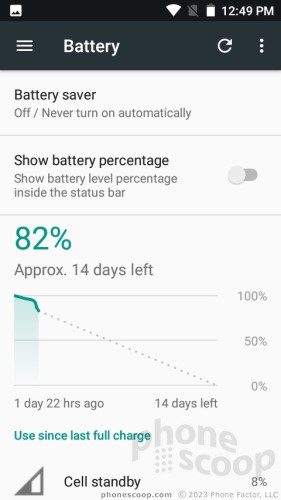
Bluetooth, GPS, NFC, WiFi
I got mixed performance from the Defiant's secondary radios.
The Bluetooth radio, for example, was a chore to use. It was fussy about pairing with other devices, particularly my car. Phone call quality via Bluetooth was pretty rough, but at least music sounded okay through my favorite Bluetooth speaker.
The GPS radio was accurate to within a few feet, but Google Maps ran poorly on the Defiant. It was often behind in real-time navigation scenarios.
The WiFi radio was a real lifesaver. Given the phone's so-so LTE 4G performance, I found myself gravitating towards WiFi connections more often. Thankfully the WiFi radio performs well.
NFC is absent from the Defiant.
Software
Lock Screen
The Defiant has a simple lock screen experience. It includes a simple ambient display, which will wake up when you receive incoming notifications. Notifications appear as white text on the black lock screen. The notifications can be hard to read outdoors or under bright light.
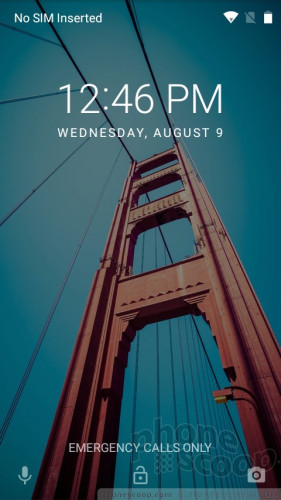
The clock stands at the top of the lock screen. Notifications pile up below it. The phone includes two lock screen shortcuts: Google Assistant on the left and the camera on the right. The drop-down Quick Settings shade is accessible on the lock screen.
Coolpad did not give the Defiant a fingerprint reader, so the phone is limited to passwords, patterns, and PINs for protection. Pick one.
Home Screen
The Defiant offers owners a stock build of Android 7 Nougat, which is nice.
All of the standard Nougat home screen features are on board. You have access to multiple home screen panels, all of which can be configured however you see fit. When you first boot the phone, the screens are speckled with a healthy dose of T-Mobile's apps and services.
The phone's app drawer contains all the installed apps. The stock Android app drawer doesn't support folders, (but you can always litter the home screen with folders of your own.) You can sort apps by install date or alpha order. There are no app suggestions at the top, though the standard search bar is still available.
The Quick Settings panel slides down from the top of the screen. Nougat allows you to arrange the Quick Settings tools to suit your own tastes. It's easy to manage notifications via the Quick Settings shade.
The full Settings menu is typical for Android. Radio controls are closest to the top, with device, account, and general settings lined up further down the vertical menu. The settings menu has its own search function to help you find and adjust settings quicker.
The Defiant ruins the usefulness of one of my favorite features in Nougat: the ability to resize screen elements. Most phones give you three options for adjusting the size of icons and apps, but the Defiant is limited to two sizes: too small, and too big. Ugh.
The Defiant uses a 1.4 GHz Snapdragon 425 processor that's paired with just 1 GB of RAM. This is not a good combo. The Defiant is slow. You won't see any problems using the home screens, but apps (particularly Google Maps and the camera) open slowly and run slowly. This phone would be much better off with 2 GB of RAM. I often found myself frustrated with the Defiant's lack of speed.
Camera
The Defiant's camera app is identical to the one on the Coolpad Canvas. You can open the camera with a double press of the lock screen button, the lock screen shortcut, or the home screen app icon.
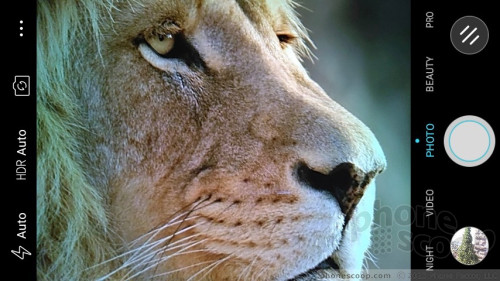
The viewfinder fills about 80% of the screen with two black strips holding the controls on either side. Shooting modes are accessed on the right, while the flash, HDR, front camera, and settings are all accessed on the left. I like that both the flash and HDR can be set to on, off, or auto. Nine filters (black-and-white, sepia, etc.) are also available by pressing a button tucked in the upper right corner.
The basic shooting modes include photo, video, night, beauty, and pro. You access each of these modes by swiping the entire camera UI up or down (just like the camera in iOS). Each mode works about as you'd expect it to. The night mode turns off the flash and essentially takes longer exposures. Results with night mode can be mixed, as you have to hold the Defiant very still to get sharp photos. The "pro" mode gives you manual control over contrast, saturation, focus, exposure, ISO, and white balance, but not shutter speed.
The beauty mode includes a sliding tool for adjusting how strong the algorithm is. Basically, the higher you slide the tool, the more aggressive the camera is about removing blemishes and smoothing your skin color. You'll start to look cartoonish if you go too far with it.
You can access panorama mode by pressing the menu button on the left. The pano mode works pretty well.
The full settings menu has a standard set of options. One thing I dislike is that the entire camera interface is locked in portrait mode, meaning the text (even in settings menus) is sideways if you hold the camera in landscape (some would say normal) orientation. Bleh.
The camera is definitely a bit slow and often takes longer to do things than it should. I blame the processor/RAM combo here.
Photos
The 5-megapixel camera really struggles. Apart from the slow experience of using the camera app itself, the images are all over the place. For the most part, the Defiant gets focus down well. You'll see some oddly soft shots here and there, but generally most photos are in focus. White balance, too, is generally accurate. Exposure is a mess. You can see totally overblown sections in some of the samples below, such as the tree, and the plant with house in the background. HDR does little to help mitigate or balance scenes that have lots of contrast.
The 2-megapixel user facing camera is pretty horrible. The shots I took of myself were soft, overexposed, and generally no good.
The Defiant is limited to capturing 720p video. The results are consistently better than those of the camera but that's not saying all that much.
There's no way I'd use the Defiant to capture important events, and it barely suffices for everyday imaging.
T-Mobile Stuff
T-Mobile crammed some bloatware onto the Defiant, but it's not too bad. It's mostly carrier-branded service s, such as mobile hotspot, visual voicemail, and Name ID. I do want to point out that the phone has just 8 GB of internal storage, and you have access to only about 4.5 GB. You're going to want to supplement the storage with a microSD memory card.
Wrap-Up
Based on my experience with the Coolpad Defiant, I can't recommend it to anyone. There are just too many problems holding it back.
The hardware itself seems fine on the surface, for a $100 phone. The Defiant is well made and the materials are good enough.
But everything takes a turn for the worse when you start using it. The display is just terrible, sound quality is so-so, and data performance left a lot to be desired. Battery life is a highlight. The core Android 7 Nougat operating system has all the features most people need, but it runs sluggishly on the under-powered phone. The camera is near disastrous, with its slow speed and results that just aren't up to par with the competition.
For $100 you can do much better. If you need to stick to T-Mobile, consider the excellent Motorola Moto E4, which costs $130 and can be purchased unlocked. If you need to stay at or below the $100 mark, it's probably a good idea to jump to T-Mobile-owned MetroPCS, which has great, affordable options such as the LG K20 Plus and ZTE Zmax Pro.
Defy the Defiant.

Comments
No messages


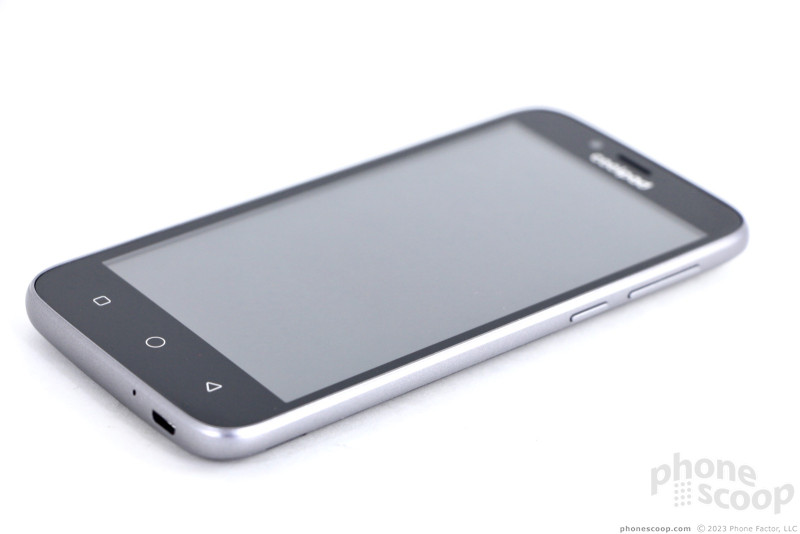




















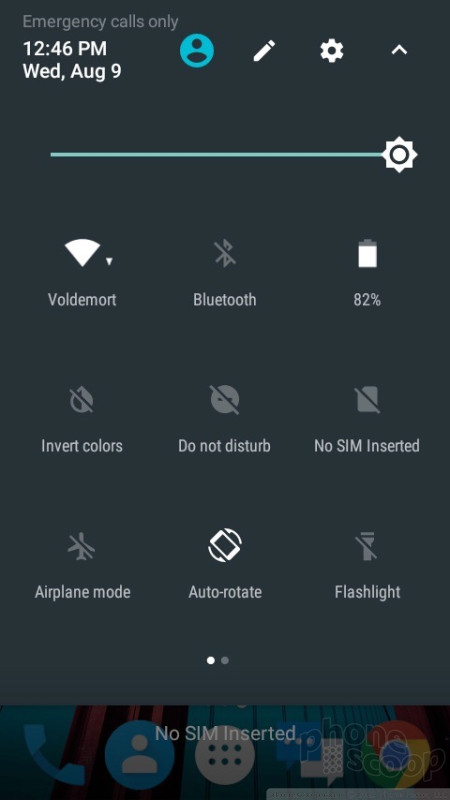



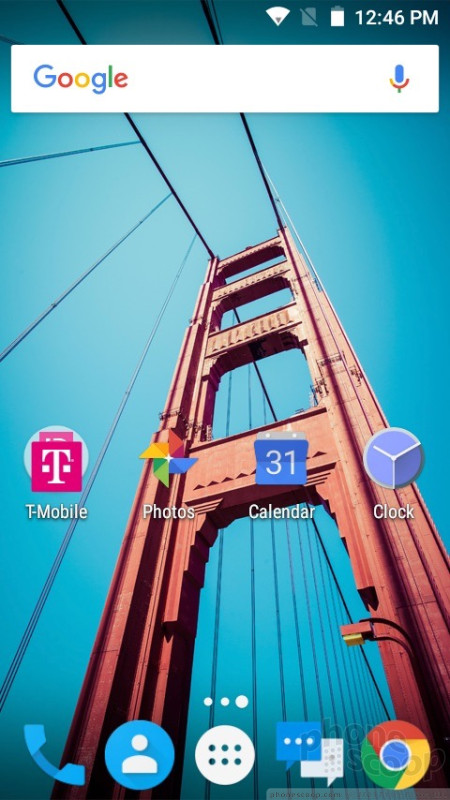










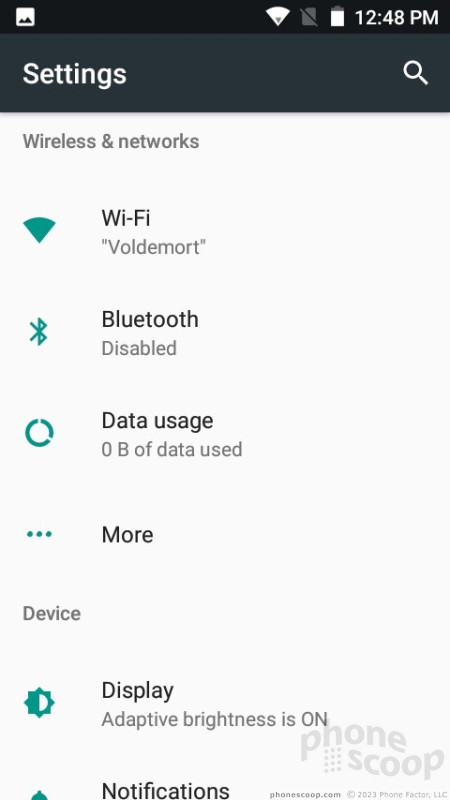



























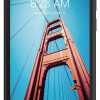 T-Mobile Now Selling the Coolpad Defiant for $100
T-Mobile Now Selling the Coolpad Defiant for $100
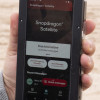 Qualcomm Taps Iridium for Satellite Connectivity
Qualcomm Taps Iridium for Satellite Connectivity
 Metro's Latest Entry-Level Phone is the TCL ION X
Metro's Latest Entry-Level Phone is the TCL ION X
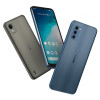 Nokia Refreshes Entry-Level Android Lineup for US
Nokia Refreshes Entry-Level Android Lineup for US
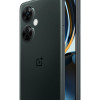 OnePlus' New Mid-Range Phone Has a 108 Megapixel Camera
OnePlus' New Mid-Range Phone Has a 108 Megapixel Camera
 Coolpad Defiant
Coolpad Defiant







